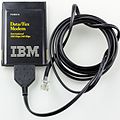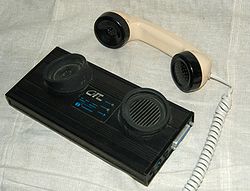Modem
A modem (comes from: modulator demodulator) is a piece of computer hardware. It is used to communicate between distant computers. Two modems, one on each computer, are required to make a connection, and each modem can send and receive data to and from the other modem.
- Modulation is changing the digital data from a computer to analog data (audio tones or sounds) to be sent over telephone lines.[1]
- Demodulation is changing the analog data which is received over the telephone lines to digital data to be used by the computer.[1]
Modems are classified by the amount of data they can send in a given time, normally measured in bits per second (bit/s, bps, or baud). They are also classified by their connection method. Dial-up modems were the usual kind in the 20th century, and DSL modems and Cable TV modems are now more used.
Modems that connect to the computer by a cable are called external modems. Modems that go inside the computer are internal modems. Some internal modems are part of the motherboard; others are inserted into the computer on a PC card. Most DSL and cable modems are external.
Many modems are used to connect to the Internet through telephone service or cable television service. Slow telephone service is called dial-up (maximum 56,000 bits per second). Faster telephone service is called DSL and is usually more than ten times faster. Cable modems connect through cable television, and are similarly fast.
A Consumer Electronics Association study in 2006 found that dial-up Internet access is on a decline in the United States. In 2000, dial-up Internet connections accounted for 74% of all U.S. residential Internet connections. This decline has been more or less mirrored in Canada and Australia.
Dial-up modem use in the US dropped to 60% by 2003, and in 2006 stood at 36%. Voiceband modems were once the most popular means of Internet access in the U.S. But as more homes adopted faster ways of accessing the Internet, the traditional 56K modem is losing popularity.
References
- ↑ 1.0 1.1
Modem Media
Acoustic coupler modems used a telephone handset as the audio medium, with the user dialing the desired number and then pressing the handset into the modem to complete the connection. These systems generally operated at a speed of 300 bits per second.
V.34 modem implemented as an internal ISA card
McBride, P. K. (1999). The Internet Made Simple (Second ed.). Made Simple. p. 18. ISBN 9780750645768.








